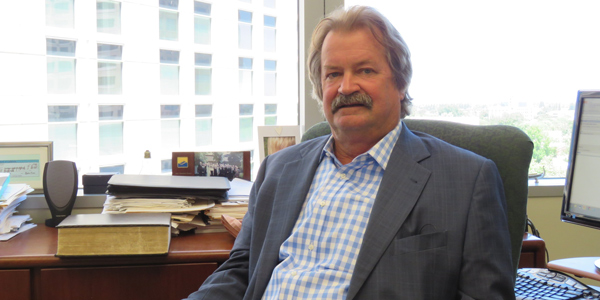By Jason Fordney
SACRAMENTO — As CEO of the Independent Energy Producers Association (IEPA), Jan Smutny-Jones has had a front-row seat in the California energy debate since 1987. IEPA represents independent energy producers including biomass, geothermal, small hydro, solar, wind, cogeneration and natural gas-fired merchant facilities, with offices just a block from the state capitol.
Smutny-Jones is an advocate for Secure California’s Energy Future, a campaign urging the State Legislature to expand CAISO’s market into other areas of the West. But some members of the State Assembly and market participants want the state to go slow on regionalization, which would require bringing representatives from other states onto the ISO’s Board of Governors. (See California Lawmakers Take Up CAISO Expansion.)
Electricity planning has changed greatly since his youth, when he watched offshore oil tankers supplying the Huntington Beach power plant as he body-surfed. But renewable generation is a decades-old concept in California, as is Western regional market coordination. There has been a lot of public debate about California’s aggressive renewable policies, but environmentally conscious planning has long been a hallmark in the Golden State for decades, Smutny-Jones says.
“Where we are today in terms of the discussion, it actually has a pretty long pedigree,” he said in a recent interview. “It isn’t like we just cooked this up in AB 32 or whatever.” Assembly Bill 32, the Global Warming Solutions Act of 2006, was a landmark law requiring the state to reduce its greenhouse gas emissions to 1990 levels by 2020.
The 2015 Clean Energy and Pollution Reduction Act, which established the state’s 50% by 2030 renewable portfolio standard, also directed the state’s energy agencies to explore transforming CAISO into a regional entity to help meet its clean energy target. More recently, the State Senate approved a bill setting a 100% renewable generation goal by 2045, the latest example of the state’s aggressive approach toward clean energy and climate change. (See California Senate Passes Bill Mandating 100% RPS.) The Assembly Committee on Utilities and Energy is due to review the legislation July 12.
Because the CAISO board is not a policymaking body but follows state policies, some lawmakers and industry stakeholders worry that regionalizing the ISO will dilute the state’s influence on the direction of energy planning, Smutny-Jones said. And other states such as Wyoming and Utah don’t want to be forced to conform to California energy policies if control of their transmission infrastructure is turned over to a regional ISO.
The Sierra Club says that if PacifiCorp’s Utah-based coal generation is brought into CAISO, for example, it will bring coal-fired power into the state, and the environmental group is pressuring the company to retire the assets. But PacificCorp in recent years has instead been investing in the plants.
“If we are expecting other states to respect California’s procurement policies, California has to be cognizant of the fact that Utah is not going to start prematurely shutting down coal plants — costing lots of money to its ratepayers — based on trying to expand the ISO,” Smutny-Jones said. Most utilities in the West are moving away from coal-fired power anyhow, so there isn’t much concern that regionalization will bolster coal generation, he said.
Building trade groups and elected officials are concerned about exporting jobs if renewable generation is shifted to other states. But lack of transmission will create a need for California-based generation, he said, and there are other land-use laws that will reduce development of utility-scale renewable generation in Western desert areas.
The list of groups supporting the regionalization plan includes Natural Resources Defense Council, Sierra Business Council, Solar Energy Industries Association, SunPower, Silicon Valley Leadership Group, and Union of Concerned Scientists.
Regionalization could help California’s natural gas-fired plants stay in business and make the market more efficient across the West, he said. The abundance of solar has put pressure on the state’s natural gas plants by changing the operational profile of the grid. In 2008, there was only about 300 MW of utility-scale solar in the state, but that figure has reached almost 10,000 MW as the cost of photovoltaics has come down and the state adopted its RPS. This has changed the operating profile for natural gas plants that are not receiving the price signals to stay in business.
“There are significant challenges in the market right now,” he said, adding that he is concerned that power plant owners will start shutting down plants and affect reliability. This will be a long-term issue that must be dealt with, he said.
Regardless of the state’s policies, a primary attraction for California renewable generation in a regional context is that it is now inexpensive, Smutny-Jones said.
“I don’t think Utah necessarily wants to buy power from California because it’s green and the right thing to do, but they will buy it if it’s cheap.”





